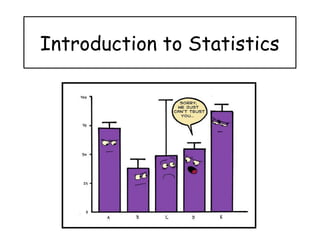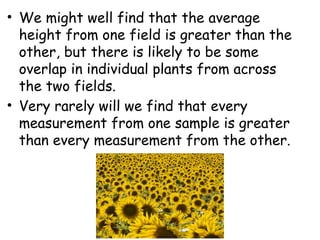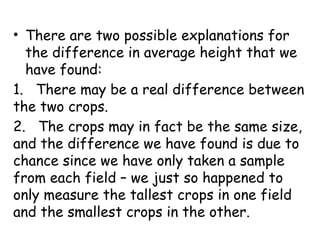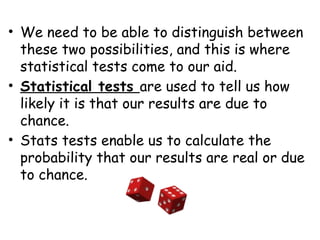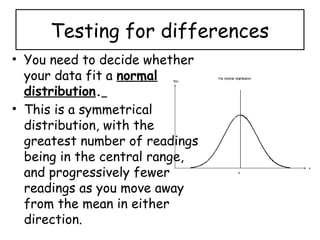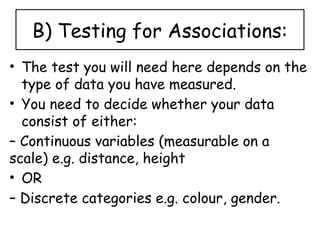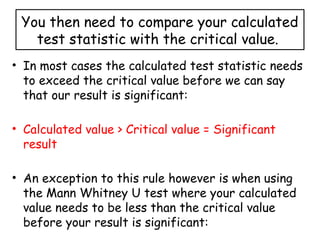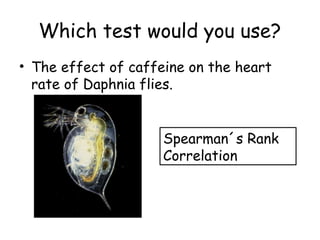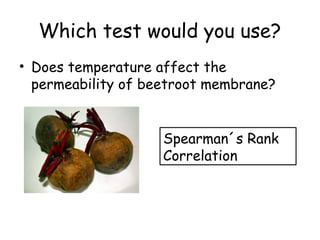Introduction to Statistics for future Biologists
- 2. • When we carry out a biological investigation, we will often end up with a lot of figures which we need to be able to interpret. • For example, we might have measured the heights of a sample of crop plants from two fields which had received different doses of fertilizer, to see if the fertilizer increases the growth of the plant.
- 3. • We might well find that the average height from one field is greater than the other, but there is likely to be some overlap in individual plants from across the two fields. • Very rarely will we find that every measurement from one sample is greater than every measurement from the other.
- 4. • There are two possible explanations for the difference in average height that we have found: 1. There may be a real difference between the two crops. 2. The crops may in fact be the same size, and the difference we have found is due to chance since we have only taken a sample from each field – we just so happened to only measure the tallest crops in one field and the smallest crops in the other.
- 5. • We need to be able to distinguish between these two possibilities, and this is where statistical tests come to our aid. • Statistical tests are used to tell us how likely it is that our results are due to chance. • Stats tests enable us to calculate the probability that our results are real or due to chance.
- 6. How do I measure probability? • Probability is normally measured on a scale from 0 – 1, where 0 represents impossibility and 1 represents certainty. • The probability that our results are due to chance could take any value between 0 and 1. • We need to agree on what level of probability we are going to accept before we decide that the difference is real.
- 7. • For most purposes, the level which is conventionally chosen is that the probability that our result is due to chance should be no more than 0.05. • This means that there is only a 1 in 20, or 5% probability that the difference we have seen is due to chance
- 8. • We can say that the difference is statistically significant. • E.g. We have not proved that one crop is taller than the other, but we will now proceed on the assumption that this is the case.
- 9. Which test? • Different statistical tests are used in different circumstances. There are a few steps to go through to tell you what test you should be using. • First you need to decide whether you are looking for differences or associations between sets of data.
- 10. Testing for differences • You need to decide whether your data fit a normal distribution. • This is a symmetrical distribution, with the greatest number of readings being in the central range, and progressively fewer readings as you move away from the mean in either direction.
- 11. • If your data roughly fits a bell shape curve and is normally distributed, you need the T test. • If not, try the Mann Whitney U test.
- 12. B) Testing for Associations: • The test you will need here depends on the type of data you have measured. • You need to decide whether your data consist of either: – Continuous variables (measurable on a scale) e.g. distance, height • OR – Discrete categories e.g. colour, gender.
- 13. How do I interpret the result from my stats test? • Once you have chosen the correct test, and put your figures into the appropriate formula, you will arrive at a figure known as the calculated test statistic. • This is not the probability figure referred to earlier, and on its own it means nothing. It needs to be compared with a critical value which varies according to your sample size and the level of probability you are demanding. • In an exam, you would be provided with an extract of such a table, from which you might be expected to extract the relevant critical value.
- 14. • Spearman Rank should be used when you are looking for associations between two continuous variables. e.g. height and age • The Chi Squared association test is the one to choose if looking for associations between categorical data. e.g. genetics test – is a condition a recessive trait?
- 15. You then need to compare your calculated test statistic with the critical value. • In most cases the calculated test statistic needs to exceed the critical value before we can say that our result is significant: • Calculated value > Critical value = Significant result • An exception to this rule however is when using the Mann Whitney U test where your calculated value needs to be less than the critical value before your result is significant:
- 16. Which test would you use? • The effect of caffeine on the heart rate of Daphnia flies. Spearman´s Rank Correlation
- 17. Which test would you use? • Is penicillin or onion more effective at killing bacteria cells T test
- 18. Which test would you use? • Does temperature affect the permeability of beetroot membrane? Spearman´s Rank Correlation
- 19. Which test would you use? • pH affects the rate of reaction of an enzyme Spearman´s Rank Correlation
- 20. Which test would you use? • The higher the temperature, the faster woodlice respire. Spearman´s Rank Correlation
- 21. Which test would you use? • There are equal proportions of species of trees in the forest. Chi squared
- 22. Which test would you use? • Daisies grow better in alkaline soil than acidic soil T test
